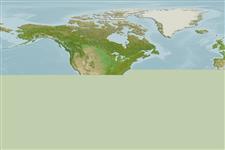Environment: milieu / climate zone / profondeur / distribution range
Écologie
marin; saumâtre pelagic-neritic; profondeur ? - 35 m (Ref. 26912). Tropical; 23°N - 27°S, 85°W - 32°W (Ref. 189)
Western Atlantic: Antilles, Trinidad south to Brazil; also Venezuela to Panama and Honduras but not Gulf of Mexico. Meristic data tends to support three geographic units: South America (east Colombia, Venezuela south to Brazil); Antillean (and some islands off Venezuela); West Caribbean (Gulf of Honduras).
Taille / Poids / Âge
Maturité: Lm ? range ? - ? cm
Max length : 14.5 cm TL mâle / non sexé; (Ref. 124483); common length : 10.0 cm TL mâle / non sexé; (Ref. 5217); poids max. publié: 21.29 g (Ref. 124483)
Épines dorsales (Total) : 0; Épines anales: 0; Rayons mous anaux: 17 - 21. Snout long and pointed, only slightly less than eye diameter; maxilla long, tip pointed, reaching almost to gill opening, teeth near tip somewhat enlarged; gill cover canals of panamensis-type; pseudobranch longer than eye diameter, with 30 or more filaments, extending onto inner face of operculum. First pectoral fin ray filamentous. Silver stripe along flank about eye diameter.
Body shape (shape guide): elongated; Cross section: oval.
A schooling species occurring in coastal waters. Trawled down to 25 m off Brazil, but equally taken in shore seines and recorded in salinities of 7.94-8.21 ppt in the Canal de Santa Cruz, Pernambuco, Brazil (Ref. 189).
Life cycle and mating behavior
Maturité | Reproduction | Frai | Œufs | Fécondité | Larves
Spawn in school (Ref. 205).
Whitehead, P.J.P., G.J. Nelson and T. Wongratana, 1988. FAO Species Catalogue. Vol. 7. Clupeoid fishes of the world (Suborder Clupeoidei). An annotated and illustrated catalogue of the herrings, sardines, pilchards, sprats, shads, anchovies and wolf-herrings. FAO Fish. Synop. 125(7/2):305-579. Rome: FAO. (Ref. 189)
Statut dans la liste rouge de l'IUCN (Ref. 130435: Version 2025-1)
Menace pour l'homme
Harmless
Utilisations par l'homme
Pêcheries: intérêt commercial mineur
Outils
Articles particuliers
Télécharger en XML
Sources Internet
Estimates based on models
Preferred temperature (Réf.
123201): 27 - 28.2, mean 27.6 °C (based on 421 cells).
Phylogenetic diversity index (Réf.
82804): PD
50 = 0.5000 [Uniqueness, from 0.5 = low to 2.0 = high].
Bayesian length-weight: a=0.00447 (0.00271 - 0.00737), b=3.20 (3.06 - 3.34), in cm total length, based on LWR estimates for this species & Genus-body shape (Ref.
93245).
Niveau trophique (Réf.
69278): 3.4 ±0.4 se; based on size and trophs of closest relatives
Résilience (Réf.
120179): Milieu, temps minimum de doublement de population : 1,4 à 4,4 années (Fec=1,644 (batch fecundity)).
Fishing Vulnerability (Ref.
59153): Low vulnerability (10 of 100).
🛈
